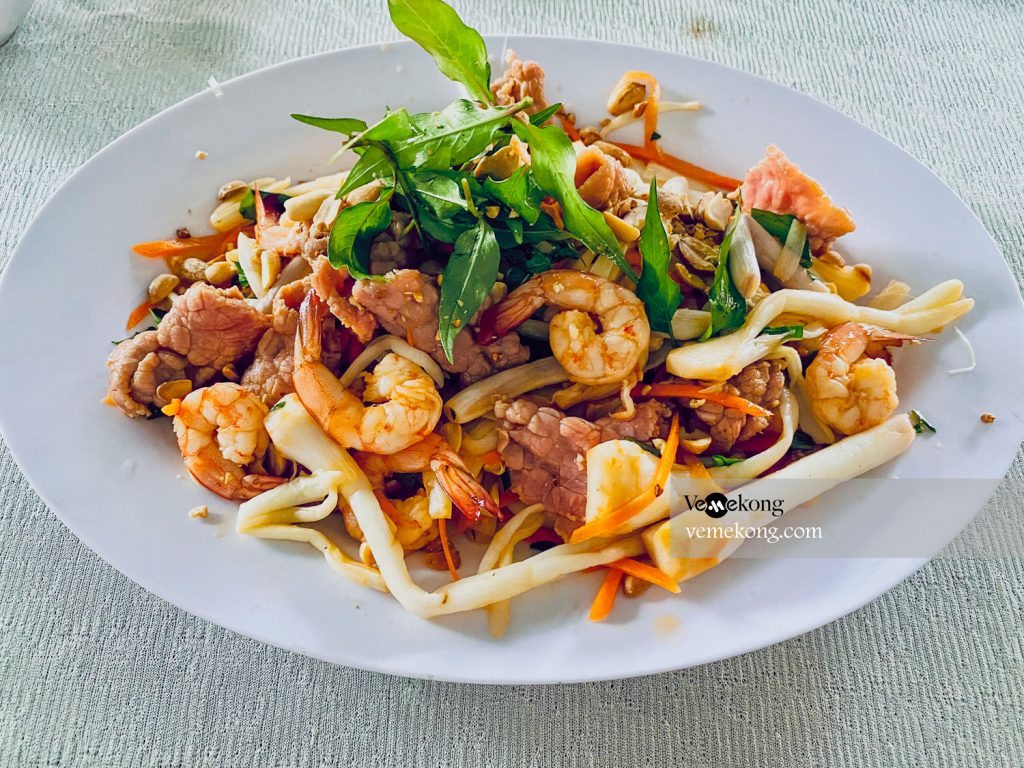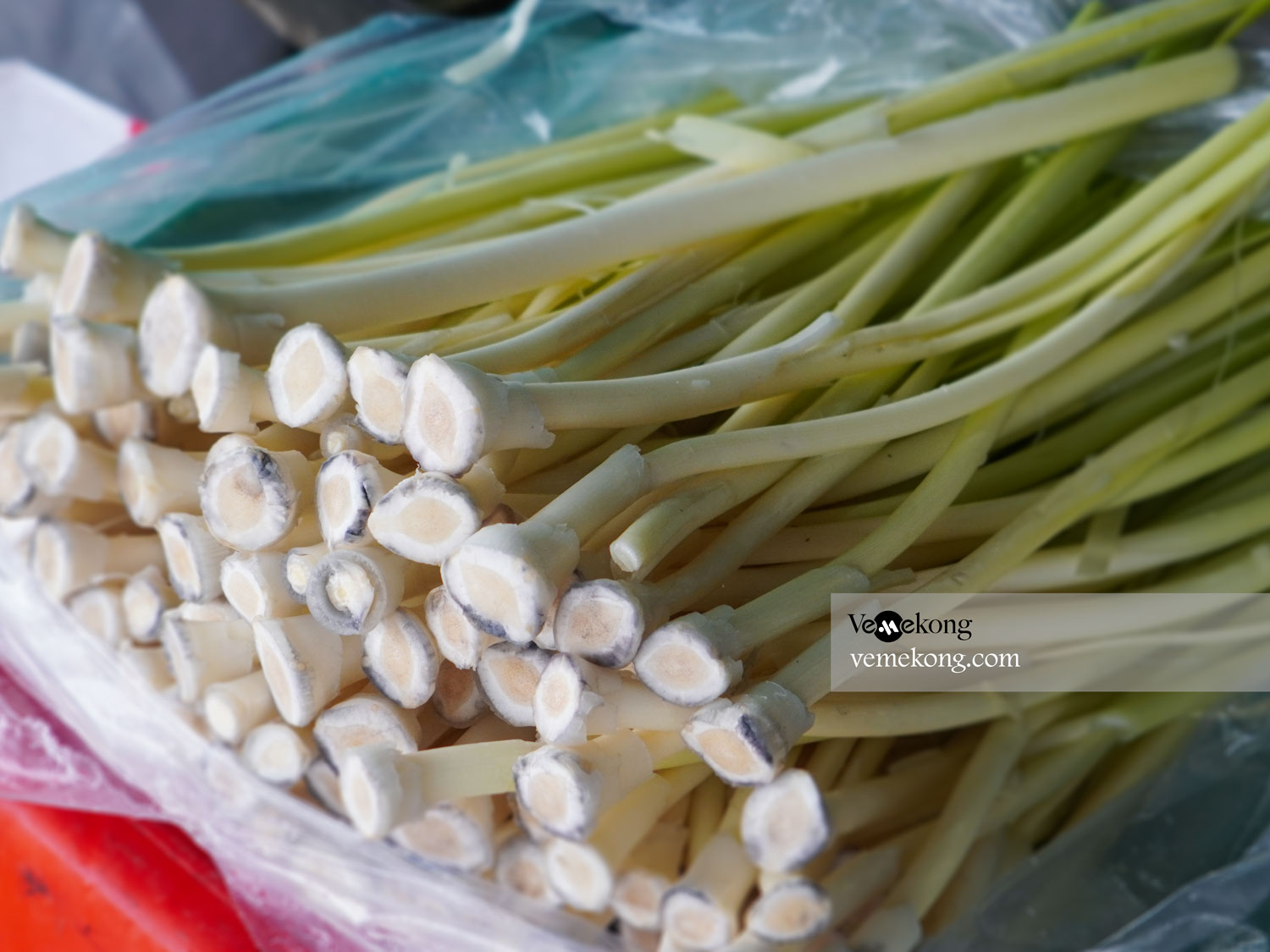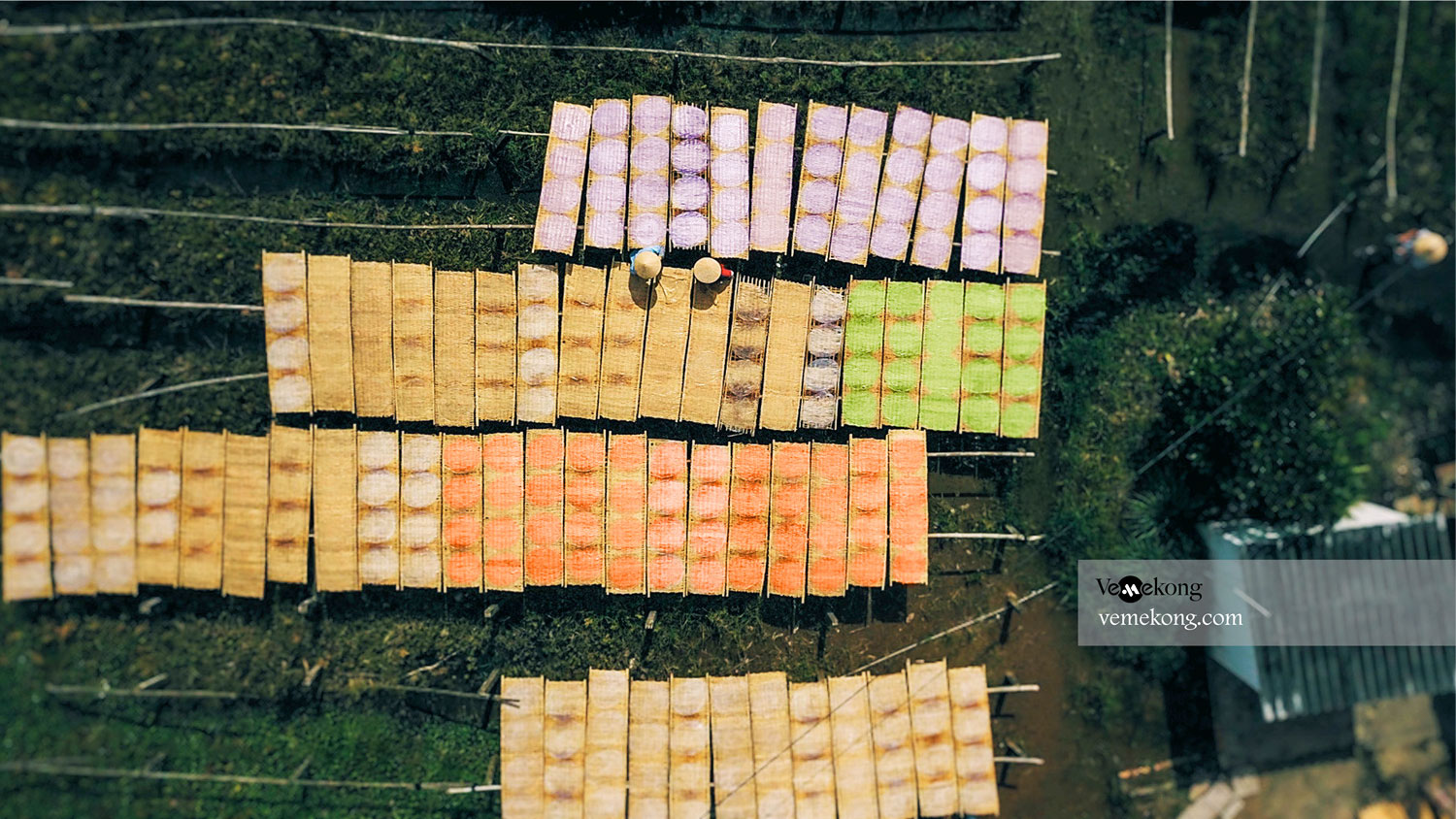This is a specialty only found in two provinces of Bac Lieu and Ca Mau. Break pieces of braised fish or braised meat, pick up some Bon Bon pickles, add one and white rice, people enjoying it will feel the attachment of this land.
By Thomas Vietnam at vemekong.com | All Best Foods & Restaurants in Bac Lieu

1. Better to Know as a Food Lover
Find them: Bac Lieu city.
Best time: Dusk-Dawn
Don’t miss: Bon Bon Pickles
Local’s pick: Bon Bon Pickles small restaurant
Tourist’s pick: Restaurant in Bac Lieu
Blog: https://vemekong.com/bon-bon-pickles-bac-lieu/
Facts: Bon Bon pickles sell well all year round. Visitors to Bac Lieu, Ca Mau all want to enjoy this dish and do not forget to bring back a few pounds as gifts for their loved ones.
2. Better to Know Bon Bon Pickles
The plant has the scientific name Typha orientalis G.A. and some others have the names: Typha auhustata Bory et Chaub, Typha augustifolia L, Typha latifoliaL, Typha daviana Hand Mazz or Typhaminima Funk … All of them belong to the family Typhaceae. Bon Bon also has many other names: Thuy Huong Bo, Huong Bodhi, Candle Grass,… is a type of grass shaped almost like sedge (sedge) weaving mats, 1-2 meters high. The leaves are long and narrow. Flowers unisexual, located on the same axis, male flowers above with short yellow-brown hairs, female flowers below with light brown hairs. The white and green leaf Bon Bon is a very healthy food that does not need to be cared for or fertilized, only growing thanks to the fertile nutrients from the soil.
If you want to enjoy the dishes from the Bon Bon, you should come to the season to have it from June to November. At this time, in many fields of the basin covered with green, the people’s job is to pull the Bon Bon out of the water. water, break the leaves, take the white buds and bring them home to make many delicious rustic dishes.
After cleaning, the white Bon Bon is processed into many different unique dishes. Simply cut into pieces and cook with coconut soup, creating a fragrant bowl of sweet and fatty coconut soup mixed with the crisp taste of the white Bon Bon. Or take a little more time, leading a little more is pickles. The white Bon Bon is split in half and put in a jar of rice water, mixed with salt water for a few days to have a concentrated pickle dish. Tuna melon is crispy, soft, with a similar combination of bamboo shoots and lotus roots. If you want to be more sophisticated, you can add chili, sugar, and garlic to add a richer flavor to the Bon Bon pickle
Bon Bon becomes a rustic, close and dear dish to the people here. This wild plant has become a unique and sweet culinary feature that appears regularly in the meals of people with muddy hands and feet.
3. Bon Bon Pickles in Bac Lieu
As a specialty, but the way to make a Bon Bon pickle is quite simple, you must first choose the young white part of the Bon Bon, use a sharp knife to split it into two or four depending on the size of the Bon Bon. Arrange the Bon Bon into the jar, mix salt and sugar into the rice water. Then, pour this mixture to cover the Bon Bon and then cover the jar tightly, about 3 days to be eaten. Tuna melon can be transformed into dishes with hot rice such as braised fish with sweet and fleshy taste, cooked carefully the sour taste of the melon will fade away, the fish meat is not fishy, soft but not crushed. Especially braised with shrimp creates a distinct aroma and a harmony of colors.
In addition to the “contributions” in cuisine, the plant also has the effect of improving the environment and ecology of wetlands, said Mr. Nguyen Dinh Hoe – Vietnam Association for the Protection of Nature and Environment: “…Group Candlestick grass (Bon Bon) has the effect of filtering water, reducing waste, especially organic matter, into lakes and lagoons, thereby reducing the possibility of eutrophication of lakes and lagoons. Candlesticks can also be used to produce ethanol. Roots are very resistant to erosion. After a long time, candelabra has played an active role in drying up the swamp… In many ways, candelabra is a precious plant species of the wetlands of the Lower South region.”
The pollen of the Bon Bon is also used in traditional oriental medicine with the name Bo Hoang, is a unisexual flower of the same root (male flower above, female flower below), the flower cluster looks like a candle, rhombic fruit. Oriental medicine often uses pollen, in addition, leaves, flowers and roots are used to make medicine. “Pink” – the most common medicine from Candelabra is pollen taken from male flowers. In April-August, cut off the upper part of the flower (the male flower part), pound or shake off the pollen, sieve to remove impurities, dry or store in a sealed jar for later use.
4. How to Make Bon Bon Pickles
Ingredients for making Bon Bon pickles:
1kg fresh Bon Bon
2 liters of rice water
1 clean glass or plastic jar
3 tablespoons salt
1.5 tablespoons sugar
1 tablespoon vinegar
How to cook Bon Bon pickles
Step 1: Cook silage rice water
First, pour 2 liters of rice water into the pot, then add 2 tablespoons of salt and 1.5 tablespoons of sugar, stir well and bring to a boil. When the mixture boils, you will see a layer of foam floating on the surface, now you should skim off that layer of foam to make the sour brine clearer.
Then you let the water cool down and pour it into a bowl with a lid to keep it for 2 days so that the fermented rice water will ferment and settle the residue.
Step 2: Prepare the Bon Bon
You should choose plants with young and fresh cores. After buying, you will separate the old core around, wash it, then use a knife to carefully separate the Bon Bon (note that now the Bon Bon is still fresh, so it is very brittle and easy to break, you should be gentle when preparing it).
Next prepare a basin of water with 1 teaspoon of salt and 1 teaspoon of vinegar, stir well to wash and remove pus on the Bon Bon (you can use alum if you want the Bon Bon to be whiter). At this point, you put the Bon Bon that has been split in half and soak it in water for about 10-15 minutes. After 15 minutes, take out the Bon Bon and wash it with cold water and then drain.
Step 3: Carry out the salting of the Bon Bon
First you clean the jar and let it dry, then you put the Bon Bons into the jar in turn. Because the Bon Bon is long, you have to bend the Bon Bon and then put it in, you should bend it gently to avoid breaking the Bon Bon, which will not be beautiful and not delicious. Next, you pour the silted rice water into the sink and use a plastic bag to press it over so that the Bon Bon is always submerged in water. And finally, fermenting the Bon Bon for 2 days is enough to enjoy.
Finished product
The pickle dish, when eaten, will have a crunchy and sour texture that is easy to eat. People in the West often like to eat this dish in many ways such as: Mixing shrimp and meat salad, served with braised fish, dipping Bon Bon melon with shrimp paste is extremely delicious and serving rice there.
5. Pro tips:
Here are our tips for easing your mind (and stomach) around food-handling environments that you may not be used to.
Make sure the food is freshly cooked. If you’re eating hot street food, it’s always safest (not to mention more delicious) to eat food you can see being cooked to order.
Look for lines and busy stalls. Busy street food stalls are an indicator of popularity, and their high turnover rate means the food is never sitting out for hours and developing dreaded bacteria. Yes, long lines can be discouraging when you’re hungry after a full day of exploring, but it’s not worth the risk of grabbing precooked food from the empty spot next door.
Eat when the locals are eating. The last and most important element here is when to eat. You’re likely already on a weird eating schedule while you’re traveling, but it’s important to try and adjust to the eating times of where you are. A bowl of pho might be lunch for Americans, but it’s breakfast for the Vietnamese. This ensures that you’re eating freshly cooked food and that you can find the best and most popular places to eat.
If you can’t drink the water, then you can’t eat the salad. Most people get so hung up on not drinking the water or skipping ice in drinks that they don’t think about all of the other ways in which water is used in food service. Fruits and vegetables tend to be washed with tap water in most places, rather than the filtered water that locals drink—or sometimes it’s not washed at all. If you’re really craving some produce, try fruits you can peel or cooked veggies.
Trust your gut. If you’re unsure about the food or the way that it’s being prepared, then keep moving. Eating street food all over the world doesn’t make you an expert. Every stall and every country are different, and sometimes the rules can be harder to follow. When something doesn’t look, smell, or feel right, don’t eat it! Trust your judgment. Chances are that there’s another spot close by that’s making something more delicious.
Eat when the locals are eating. The last and most important element here is when to eat. You’re likely already on a weird eating schedule while you’re traveling, but it’s important to try and adjust to the eating times of where you are. A bowl of pho might be lunch for Americans, but it’s breakfast for the Vietnamese. This ensures that you’re eating freshly cooked food and that you can find the best and most popular places to eat.
If you can’t drink the water, then you can’t eat the salad. Most people get so hung up on not drinking the water or skipping ice in drinks that they don’t think about all of the other ways in which water is used in food service. Fruits and vegetables tend to be washed with tap water in most places, rather than the filtered water that locals drink—or sometimes it’s not washed at all. If you’re really craving some produce, try fruits you can peel or cooked veggies.
Trust your gut. If you’re unsure about the food or the way that it’s being prepared, then keep moving. Eating street food all over the world doesn’t make you an expert. Every stall and every country are different, and sometimes the rules can be harder to follow. When something doesn’t look, smell, or feel right, don’t eat it! Trust your judgment. Chances are that there’s another spot close by that’s making something more delicious.
Must-Eat Foods & Restaurants in Can Tho: Co Ut’s Cong cake, Ut Dzach Fine Rice Vermicelli, Thanh Van Grilled Pork Sausage, Crab Noodle Soup At Floating Market, Scorched Rice with Caramelized Fish Sauce, 7-Toi’s Duck Meat Pancake, Banh Mi Thuy, Banana Blossom Salad, Fried Spring Rolls, Fresh Spring Rolls, Fetal duck egg (balut), Honeycomb Cake, Mini Sticky Rice Cake, Cassava Silkworm Cake, Grilled Banana Wrapped in Sticky Rice, Khmer-style Bun Goi Da Soup, Egg Coffee, Con Son Grilled Snakehead Fish, Bun Mam – Fermented Fish Noodle Soup, Lau Mam – Fermented Fish Hotpot, Grilled Snails with Pepper, Magenta Sticky Rice Cake, Duck cooked with Fermented Tofu, Rice Noodle Pizza, Vegetarian Noodle Soup, Snails Stuffed With Pork…
Must-Eat Foods & Restaurants in Chau Doc: Chau Doc Fish Noodle Soup, Sugar Palm Fruit, Basa Fish Hot Pot, Mam (Fermented fish), Phu Huong Beef Noodle Soup, Broken Rice with Pork Chop, Long Xuyen Broken Rice, Nui Cam Pancake, O Thum’s Chicken Grilled with Lime Leaves, Stir-fried Shrimp with Sesbania Flower, Sweet & Sour Soup with Siamese Mud Carp Soup & Sesbania Flower, Caramelized & Braised Catfish, Grilled Rice-field Rat with Salt and Chili…
Must-Eat Foods & Restaurants in Soc Trang: Pia Cake, Cong Cake (Banh Cong), Bun Nuoc Leo Soc Trang’s Noodle Soup, Soc Trang’s Bun Goi Da Soup, Duck Noodle Soup with black Pepper, Curry Noodle Soup, Grilled Beef on Tile, Khmer-style Tube Cake, Khmer-style Mung Bean Cake (Banh In), Dried Radish (Xa Bau), Stir-Fried Noodles with Seafood (Mi Sua), Soc Trang’s Green Rice Flakes…
Must-Eat Foods & Restaurants in Ben Tre: Phu Le Rice Wine, Ben Tre’s Coconut Candy, Flat Banana, Coconut Rice, Snail Pancake, Sea Snail with Coconut Milk, Coconut Worm, Young Coconut Salad with Shrimp & Pork, Son Doc Puff Rice Paper…
Must-Eat Foods & Restaurants in Cai Be: Puffed Rice Cake…
Must-Eat Foods & Restaurants in Vinh Long: Elephant Ear Fish (fried giant gourami)…
Must-Eat Foods & Restaurants in My Tho: Fried Sticky Rice, Snakehead Fish Rice Porridge, Hu Tieu My Tho (Noodle Soup), Coconut Banana Cake…
Must-Eat Foods & Restaurants in Tra Vinh: Macapuno Coconut, Bun Nuoc Leo Tra Vinh’s Noodle Soup, Tra Cuon’s Sticky Rice Cake…
Must-Eat Foods & Restaurants in Sadec: Sa Dec Noodle Soup, Sadec Crab Hotpot, Lai Vung Spring Rolls, Sa Giang Shrimp Puff Pastry, Lai Vung Tangerine…
Must-Eat Foods & Restaurants in Bac Lieu: Spicy Beef Noodle Soup, Bac Lieu’s Three-striped Crab, White Radish Pies, Bac Lieu Thick Noodles & Creamy Coconut Milk, Bon Bon Pickles…
Must-Eat Foods & Restaurants in Ca Mau: Banh tam ga cay (Silkworm rice cake with curried chicken), Grilled Vop clams with salt and pepper, Grilled Mudskipper Fish, Stone Crab Roast With Salt, Young Bee Salad, Nam Can’s Crab, U Minh Forest’s Honey, U Minh’s Fermented Fish Hotpot…
Must-Eat Foods & Restaurants in Hau Giang: Cau Duc Pineapple, Cai Tac’s Pork Organs Porridge, Hau Giang’s Bronze Featherback Fish Cake…
Must-Eat Foods & Restaurants in Ha Tien: Herring Fish Salad, Spider crab cake soup, Ken Noodle soup, Xoi Xiem (Siamese sticky rice), Steamed Noodle soup, Ha Tien Oyster porridge…
Must-Eat Foods & Restaurants in Rach Gia: Stir Noodle Soup, Kien Giang Fish Noodle Soup…
Must-Eat Foods & Restaurants in Con Dao: Bang nut jam, Vu Nang Snail, Roasted Pork Bread (Banh Mi), Coconut Ice Cream…
Must-Eat Foods & Restaurants in Phu Quoc: Phu Quoc Sim Wine, Phu Quoc Pepper, Phu Quoc fish sauce…
Hopefully, the above tips will help you to come up with a great plan for your adventure in Mekong River Delta, Vietnam. Have a safe trip!
“Sleep less, travel more, respect more” – Thomas Vietnam – Local travel expert.
Thank you

